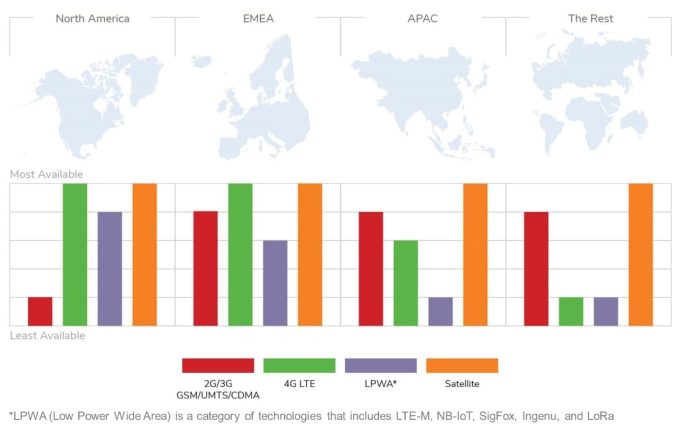LTE-M and NB-IoT networks are being cited as the next evolution for cellular IoT deployments. These new, low-power, low-cost networks will enable a new wave of IoT use cases while providing additional benefits to existing connected solutions. But LTE-M and NB-IoT networks are highly constrained networks that will create material bandwidth limitations not previously seen, even with the 2G networks they will replace, and this will cause challenges for remote software updates. In this article, we’ll explore the specific limitations of LTE-M and NB-IoT networks, expose the challenges for IoT deployments, outline the key business implications, and present a solution to consider.
LTE-M and NB-IoT advantages
LTE-M and NB-IoT devices have several advantages for builders of IoT applications. They have a wider range and longer reach than other devices, they use less power and thus have longer battery life, and they are lower in cost. In addition, these network technologies are low bandwidth, which is more cost-effective for a range of applications such as GPS trackers, parking sensors, lighting sensors, and remote monitoring devices (Figure 1).

2G networks that currently run IoT traffic will eventually be phased out. These phase-outs will occur in different times in different parts of the world, but eventually, 2G will be gone. LTE-M and NB-IoT are the successor technologies (Figure 2). While there are current coverage limitations in LTE-M and NB-IoT networks, these will be addressed over time as the networks are deployed around the world.

Remote update challenges
All IoT devices need to be remotely updated from time to time. Software updates, security patches, and regulatory changes all drive the need for updates. However, updating devices remotely over wireless networks can be problematic. There are two key challenges transmitting over-the-air (OTA) updates in low-bandwidth networks like LTE-M and NB-IoT: device availability and network congestion.
Availability – Most low-power IoT devices are half-duplex, so they can only transmit or receive (not both simultaneously) at any given time. They either transmit northbound (data from device to cloud) or southbound (data from cloud to device, e.g. for OTA updates). Most NB-IoT or LTE-M devices are optimized for northbound communications, but southbound transmissions are critical for bug fixes and security patches. The challenge is that some devices may be transmitting data northbound when an OTA update comes in, so the update cannot be delivered successfully, thus requiring the sender to retry the transmission at a later time.
Network Congestion – In low-bandwidth networks like NB-IoT and LTE-M, there’s an impact on the ability of compatible devices to transmit data. With the wide proliferation of IoT, there will be an increasing number of devices per cell tower, and in situations where there are hundreds of devices on a single tower, there will inevitably be congestion in the network. This congestion will prevent OTA updates from occurring in a timely manner, thereby causing higher costs (from several manual retries) and leaving the devices vulnerable for longer periods of time (missed security patches, etc.).
In some cases, it can cost thousands of dollars to successfully complete just one OTA update. For example, a connected healthcare provider wanted to send a security update to 500,000 IoT devices. Because the updates were ‘blind’ (the sender had no visibility into connectivity status of the devices), the provider sent updates to 10,000 devices at a time and retried them when no acknowledgements were received. It took over six months to complete the entire update.
Awareness – Connectivity awareness is a fundamental challenge, the lack of which increases OTA update costs and extends the time it takes to complete them. OTA updates are typically executed by operations personnel who manually transmit them, wait for acknowledgement, and then retry the updates that didn’t go through. Updates are often sent out without the sender knowing whether the device is online or whether it is capable of receiving the update at any given time. In many situations, network congestion or the device’s being busy transmitting data mean that multiple retries are necessary before updates are 100 percent complete. The more retries, the higher the cost – not just transmission costs, but also personnel costs to manually do the retries.
The solution: Automation and connectivity awareness
The solution is software automation and connectivity awareness. Software automation eliminates manual sending and retries for updates, and connectivity awareness means the software knows when devices are ready to receive updates, and whether or not the cell tower is congested. Handling this in software minimizes the time to complete OTA updates and eliminates human interaction, delivering more timely updates and lower costs. With this knowledge, IoT solution providers can send updates with a far higher likelihood of success, and most updates can be completed within 24 hours without human intervention.
LTE-M and NB-IoT will deliver the next generation of connectivity for IoT devices, but providers must be aware of the challenges of managing devices in these low-power, low-bandwidth networks. With the proper software support, critical OTA updates can be made quickly and at a reasonable cost.
Author bio
Amit Khetawat is the Vice President of Product Management at Aeris Communications. In this role, he is responsible for the strategy and management of their IoT connectivity services including connectivity aware micro-services and applications.

